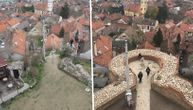Do you know which is Belgrade's oldest street? It is more than 1,500 years old
Right next to the oldest Belgrade street that has been discovered, at a depth of several more meters, a child's tomb was found dating from the 4th or the early 5th century.
There are more than 5,500 streets in Belgrade and each has or hides its own story. Many of them are known beyond the borders of the country, such as Vase Carapica and Knez Mihailova, said to have been the center of the old Singidunum during the Roman times. Karadjordjeva, Cara Dusana, Kralja Petra, Balkanska and many others are also well known. They all pulse with their distinctive rhythm in the city center, attracting visitors, both in terms of their content, and their names and roles that they had in the past of our capital and our people.
It is indisputable that the Sava and Danube rivers played a crucial role in making sure the history of Belgrade extends up to 6,000 years into the past. Throughout history, rivers have been the fastest, safest, and cheapest way of transportation and communication. And if we add to that the natural hill at the confluence - there's Kalemegdan and Belgrade, the epicenters of centuries-old events. In the millennium of settlements on the Sava and Danube banks, there have been too many.
If we go back 1.5 centuries to the past, the town was called Singidunum. It was an important strategic site along Via Militaris, a significant Roman road linking fortresses and settlements along the Danube toward the border of the empire, "limes" in Latin. On the other side of that border were belligerent tribes and peoples.
It was the time of the definitive splitting of the Roman Empire into two parts, when Singidunum found itself on the northwestern border of the Eastern Roman Empire from which Byzantium originated. It was a tumultuous period associated with the Hun invasions, who captured and destroyed Singidunum in 441 AD. Four years later, the Eastern Roman Empire reclaimed the city. Then the Sarmatians came to the conquest, then the Ostrogoths, then in 470 the Gepids, but they were expelled again by the Ostrogoths. The Eastern Roman Empire was again in Singidunum in 510 AD. It was next devastated by the Avars. The Romans once again returned to the city eight years later. Finally, around 630, the Slavs settled in the area around Singidunum.
Through all these events, on a rock above the confluence of the Sava into the Danube, a Roman castrum (military fort) was formed first - around which this town was built.
A cobblestone 1,500 years old
Many centuries later, in the archaeological layers of the access to the Eastern Gate of the Belgrade Fortress, a cultural layer was discovered, which tells about the life in settlements on the Sava and Danube banks, in the second and third centuries, as well as during the early Byzantine times of the sixth and sixth centuries. Archaeologists, not too long ago, found the oldest street in Belgrade while studying the city's past.
It is located in Lower Town, at the foot of Kalemegdan on the right bank of the Danube, between the East, the Charles VI and Vidin gates. It is a remnant of a street, that served as access communication that led to Lower Town from the part of the city around present-day Dusanova Street, and is believed to date from the Roman and early Byzantine times. The cobblestone is a millennium and a half old, speaking for itself and complementing the mosaic of the rich history of the capital city.
The street's importance is especially evidenced by the fact that it was covered with cobblestone, which indicates both its importance when it comes to communication, but also the level of organization of Belgrade at the time. Traces left by wheels on the cobblestones are still visible today, showing that it was used. And that's not all. Below the layers on which this street lies, remains from of ancient and post-ancient era have been discovered.
The secret of an ancient tomb
However, this is not the only secret that this Danube slope hides. Immediately next to the discovered, now known to be the oldest preserved Belgrade street, a child's grave was found at a depth of several meters, dating from the 4th or the beginning of the 5th century.
Although this fact is surprising to us today, in Roman times it was the custom to bury the dead along the main roads, and so burials were done along that street which led to part of the settlement on the Lower Town Plateau.
This part of Kalemegdan, an extraordinary historical treasure, holds many secrets from Belgrade's past. In this respect, Kalemegdan represents a true archaeological pearl, a monumental heritage for future archaeological research.
(Telegraf.rs/011info.com)

